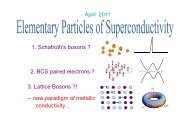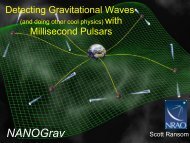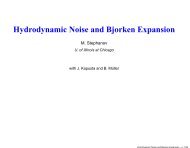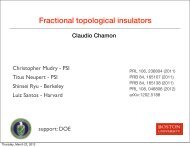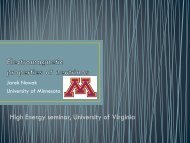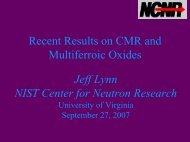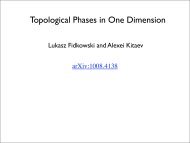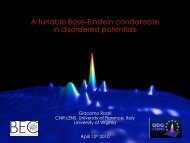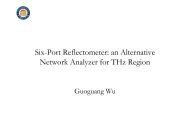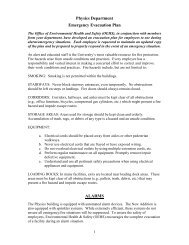E = mc^2, High energy and intensity opens windows on the world
E = mc^2, High energy and intensity opens windows on the world
E = mc^2, High energy and intensity opens windows on the world
Create successful ePaper yourself
Turn your PDF publications into a flip-book with our unique Google optimized e-Paper software.
E = mc 2<br />
Opening Windows <strong>on</strong> <strong>the</strong> World<br />
Young-Kee Kim<br />
Fermilab <str<strong>on</strong>g>and</str<strong>on</strong>g> <strong>the</strong> University of Chicago<br />
Physics Department Colloquium<br />
University of Virginia<br />
September 4, 2009
What is <strong>the</strong> <strong>world</strong> made of?<br />
What holds <strong>the</strong> <strong>world</strong> toge<strong>the</strong>r?<br />
Where did we come from?<br />
<strong>the</strong> smallest things in <strong>the</strong> <strong>world</strong><br />
interacti<strong>on</strong>s (forces) between <strong>the</strong>m<br />
<strong>the</strong> Universe’s past, present, <str<strong>on</strong>g>and</str<strong>on</strong>g> future<br />
Particle Physics: physics where<br />
small <str<strong>on</strong>g>and</str<strong>on</strong>g> big things meet,<br />
inner <str<strong>on</strong>g>and</str<strong>on</strong>g> outer space meet
Accelerators are<br />
powerful tools<br />
for Particle Physics!<br />
Tevatr<strong>on</strong>, Fermilab, Chicago, USA<br />
2 TeV prot<strong>on</strong>-antiprot<strong>on</strong> collider<br />
Operating since 1985<br />
Neutrino beams<br />
KEKb, KEK, Tsukuba, Japan<br />
10 GeV e - e + collider<br />
Operating since 1999<br />
LHC, CERN, Geneva, Switzerl<str<strong>on</strong>g>and</str<strong>on</strong>g><br />
714 TeV prot<strong>on</strong>-prot<strong>on</strong> collider<br />
Expect to start operati<strong>on</strong>s late 2009
Accelerators are Powerful Microscopes.<br />
They make high <str<strong>on</strong>g>energy</str<strong>on</strong>g> particle beams<br />
that allow us to see small things.<br />
λ = h p<br />
seen by<br />
low <str<strong>on</strong>g>energy</str<strong>on</strong>g> beam<br />
(poorer resoluti<strong>on</strong>)<br />
seen by<br />
high <str<strong>on</strong>g>energy</str<strong>on</strong>g> beam<br />
(better resoluti<strong>on</strong>)
Accelerators are also Time Machines<br />
because <strong>the</strong>y make particles last seen<br />
in <strong>the</strong> earliest moments of <strong>the</strong> universe.<br />
particle beam<br />
anti-particle<br />
target
Accelerators are also Time Machines<br />
because <strong>the</strong>y make particles last seen<br />
in <strong>the</strong> earliest moments of <strong>the</strong> universe.<br />
particle beam<br />
anti-particle<br />
target<br />
ka<strong>on</strong><br />
neutrino<br />
mu<strong>on</strong>
Accelerators are also Time Machines<br />
because <strong>the</strong>y make particles last seen<br />
in <strong>the</strong> earliest moments of <strong>the</strong> universe.<br />
particle beam<br />
<str<strong>on</strong>g>energy</str<strong>on</strong>g><br />
Energy<br />
anti-particle beam<br />
<str<strong>on</strong>g>energy</str<strong>on</strong>g><br />
Particle <str<strong>on</strong>g>and</str<strong>on</strong>g> anti-particle annihilate.<br />
E = mc 2
Accelerators are also Time Machines<br />
because <strong>the</strong>y make particles last seen<br />
in <strong>the</strong> earliest moments of <strong>the</strong> universe.<br />
E = Mc 2<br />
particle beam<br />
<str<strong>on</strong>g>intensity</str<strong>on</strong>g><br />
M<br />
m ν<br />
M N
Many generati<strong>on</strong>s of Accelerators created<br />
with higher <str<strong>on</strong>g>and</str<strong>on</strong>g> higher <str<strong>on</strong>g>energy</str<strong>on</strong>g> <str<strong>on</strong>g>and</str<strong>on</strong>g> <str<strong>on</strong>g>intensity</str<strong>on</strong>g> beams<br />
1929 Today (Fermilab)<br />
~2000 Scientists<br />
Fermilab experiments using accelerators<br />
> 2 publicati<strong>on</strong>s every week<br />
~2 Ph.D.s every week<br />
Ernest Lawrence<br />
(1901 - 1958)<br />
Tevatr<strong>on</strong>: x10 4 bigger, x10 6 higher <str<strong>on</strong>g>energy</str<strong>on</strong>g><br />
Intense neutrino beams
With advances in accelerators, we discovered many surprises.<br />
Intensity<br />
Energy<br />
The field of Particle Physics has been<br />
tremendously successful in creating <str<strong>on</strong>g>and</str<strong>on</strong>g> establishing<br />
“St<str<strong>on</strong>g>and</str<strong>on</strong>g>ard Model of Particle Physics” answering<br />
”what <strong>the</strong> universe is made of” <str<strong>on</strong>g>and</str<strong>on</strong>g> “how it works”
Scientific Drivers<br />
• Present <strong>the</strong>ory (St<str<strong>on</strong>g>and</str<strong>on</strong>g>ard Model)<br />
is a remarkable intellectual<br />
c<strong>on</strong>structi<strong>on</strong><br />
• Every particle experiment ever<br />
d<strong>on</strong>e (except neutrino expt.s) fits<br />
in <strong>the</strong> framework<br />
Quarks<br />
H<br />
Force<br />
Carriers<br />
• But huge questi<strong>on</strong>s remain<br />
unanswered.<br />
• New physics is required to answer<br />
– e.g. Supersymmetric extensi<strong>on</strong> of SM,<br />
extra dimensi<strong>on</strong>s, ….<br />
Lept<strong>on</strong>s<br />
H (Higgs) yet to be discovered<br />
Pier Odd<strong>on</strong>e, DOE SC<br />
Planning, April 29, 2009
What is <strong>the</strong> universe made of?<br />
~90 years ago ~60 years ago ~40 years ago Present<br />
atom<br />
electr<strong>on</strong> 10 -19 m ~ 1 TeV<br />
nucleus<br />
1<br />
100,000 of human hair prot<strong>on</strong><br />
neutr<strong>on</strong><br />
prot<strong>on</strong><br />
neutr<strong>on</strong><br />
up quark<br />
down quark<br />
up quark<br />
down quark<br />
Ru<strong>the</strong>rford<br />
1<br />
10,000<br />
1<br />
10<br />
1<br />
100,000
Everything is made of electr<strong>on</strong>s, up quarks <str<strong>on</strong>g>and</str<strong>on</strong>g> down quarks.<br />
Are <strong>the</strong>y <strong>the</strong> smallest things?
(prot<strong>on</strong> mass = = ~1GeV/c 2 )<br />
top quark<br />
τ<br />
ḅ<br />
c c .ν µ<br />
.<br />
ν τ<br />
Z<br />
W<br />
glu<strong>on</strong>s<br />
Why so many elementary particles?<br />
Why 3 families?<br />
Where does mass come from? Higgs?<br />
Origin of neutrino mass?<br />
Would charged lept<strong>on</strong>s oscillate?<br />
Did <strong>the</strong>y all come from ONE?
What holds <strong>the</strong> <strong>world</strong> toge<strong>the</strong>r?<br />
Beginnings of Unificati<strong>on</strong><br />
Gravitati<strong>on</strong>al Force Electromagnetic Force<br />
Issac Newt<strong>on</strong><br />
(1642 - 1727)<br />
James Clerk Maxwell<br />
(1831 - 1879)
Unificati<strong>on</strong> of Gravity <str<strong>on</strong>g>and</str<strong>on</strong>g> Electromagnetism?<br />
Einstein tried to unify<br />
electromagnetism <str<strong>on</strong>g>and</str<strong>on</strong>g> gravity<br />
but he failed.
adioactive decays<br />
Enrico Fermi<br />
(1901 - 1954)<br />
holding prot<strong>on</strong>, nucleus<br />
1 fm = 10 -15 m<br />
glu<strong>on</strong>s
Dream of Unificati<strong>on</strong> c<strong>on</strong>tinues!<br />
We believe that <strong>the</strong>re is an underlying simplicity<br />
behind vast phenomena in nature.<br />
Do all <strong>the</strong> forces become <strong>on</strong>e?<br />
At high <str<strong>on</strong>g>energy</str<strong>on</strong>g>, do forces start to behave <strong>the</strong> same<br />
as if <strong>the</strong>re is just <strong>on</strong>e force, not several forces?<br />
Extra hidden dimensi<strong>on</strong>s in space?
Particle Physics & Cosmology Questi<strong>on</strong>s from<br />
Astrophysical Observati<strong>on</strong>s
Everything is made of electr<strong>on</strong>s, up quarks <str<strong>on</strong>g>and</str<strong>on</strong>g> down quarks.<br />
Everything that we can see<br />
Galaxies are held toge<strong>the</strong>r by mass<br />
far bigger (x5) than all stars combined.<br />
Dark Matter - What is it?
Where did we come from?<br />
How did we get here?<br />
Where are we going?<br />
Underst<str<strong>on</strong>g>and</str<strong>on</strong>g>ing our Universe!
Create particles & antiparticles that<br />
existed ~0.001 ns after Big Bang:<br />
Tevatr<strong>on</strong>, LHC, ….<br />
Accelerators<br />
Inflati<strong>on</strong><br />
Big<br />
Bang<br />
particles<br />
anti-particles<br />
Where did all antimatter go?<br />
particles
Not <strong>on</strong>ly is <strong>the</strong> Universe exp<str<strong>on</strong>g>and</str<strong>on</strong>g>ing, it is<br />
Accelerating!!<br />
Where does <str<strong>on</strong>g>energy</str<strong>on</strong>g> come from?<br />
Dark Energy
What is <strong>the</strong> <strong>world</strong> made of?<br />
What holds <strong>the</strong> <strong>world</strong> toge<strong>the</strong>r?<br />
Where did we come from?<br />
Primitive Thinker
1. What is <strong>the</strong> origin of mass for fundamental particles?<br />
2. Why are <strong>the</strong>re so many kinds of particles?<br />
3. Do all <strong>the</strong> forces become <strong>on</strong>e?<br />
4. Are <strong>the</strong>re extra dimensi<strong>on</strong>s of space?<br />
5. What are neutrinos telling us?<br />
6. What happened to <strong>the</strong> antimatter?<br />
7. What is dark matter?<br />
8. How can we solve <strong>the</strong> mystery of dark <str<strong>on</strong>g>energy</str<strong>on</strong>g>?<br />
9. How did <strong>the</strong> universe come to be?<br />
10. Are <strong>the</strong>re undiscovered principles of nature:<br />
new symmetries, new physical laws?<br />
Evolved Thinker
X<br />
E<br />
Tevatr<strong>on</strong>, LHC<br />
ILC, CLIC, Mu<strong>on</strong> Collider<br />
E = m X c 2<br />
ν µ<br />
m ν<br />
ν µ<br />
ν e<br />
M N<br />
X<br />
Young-Kee Kim Fermilab Strategic Plan Slide 26
Particle Physics in <strong>the</strong> World<br />
Fermilab<br />
CERN<br />
KEK
A herd of American bis<strong>on</strong>, symbolizing Fermillab’s presence <strong>on</strong> <strong>the</strong><br />
fr<strong>on</strong>tiers of particle physics <str<strong>on</strong>g>and</str<strong>on</strong>g> <strong>the</strong> c<strong>on</strong>necti<strong>on</strong> to its prairie origins.<br />
6,800-acre park-like site<br />
Wils<strong>on</strong> Hall
2008 Nobel Prize in Physics<br />
Nambu (Univ. of Chicago)<br />
Kobayashi (KEK) – Maskawa (Kyoto Univ.)<br />
for “Mechanism of Symmetry Breaking”<br />
Wils<strong>on</strong><br />
Hall<br />
“Broken Symmetry”
The Energy Fr<strong>on</strong>tier: “Tevatr<strong>on</strong>”<br />
The Intensity Fr<strong>on</strong>tier: Neutrino Beams<br />
Neutrinos<br />
CDF<br />
Tevatr<strong>on</strong>:<br />
operati<strong>on</strong>s through 2011<br />
DØ
Origin of Mass:<br />
There might be something (new particle?!) in <strong>the</strong> universe<br />
Electr<strong>on</strong><br />
that gives mass to particles<br />
Nothing in <strong>the</strong> universe Something in <strong>the</strong> universe<br />
Higgs Particles:<br />
x<br />
x<br />
mass<br />
Z,W Bos<strong>on</strong><br />
Top Quark<br />
x x<br />
x<br />
x<br />
x xx x x<br />
x<br />
x<br />
Mass<br />
∞<br />
coupling strength to Higgs
Tevatr<strong>on</strong>: Improve Higgs Mass Pred. via Quantum Correcti<strong>on</strong>s<br />
1 GeV = 1 GeV / c 2 ~ prot<strong>on</strong> mass<br />
W (GeV)<br />
M W<br />
80.5<br />
80.4<br />
M top : Tevatr<strong>on</strong><br />
M W : Tevatr<strong>on</strong> + LEP2<br />
W<br />
top<br />
bottom<br />
80.3<br />
W<br />
Higgs<br />
150 175 200<br />
M top (GeV)<br />
M W <str<strong>on</strong>g>and</str<strong>on</strong>g> M top measurements favor light Higgs < ~180 GeV<br />
LEP2 direct searches – excluded Higgs < 114 GeV at 95% CL<br />
Favored Higgs mass range (114 – 180 GeV) is great for <strong>the</strong> Tevatr<strong>on</strong>!
σ<br />
mb -<br />
µb -<br />
nb -<br />
pb -<br />
fb -<br />
Physics at <strong>the</strong> Tevatr<strong>on</strong><br />
Observed so far<br />
-<br />
-<br />
Total Inelastic<br />
jets (qq, qg, gg)<br />
-<br />
bb<br />
-<br />
W<br />
Z<br />
tt -<br />
WZ, Single Top, ZZ<br />
Higgs<br />
WH,ZH<br />
Light SUSY, ….<br />
100 120 140 160 180 200<br />
Higgs Mass [GeV/c 2 ]<br />
-
Tevatr<strong>on</strong>: Improve Higgs Mass Pred. via Quantum Correcti<strong>on</strong>s<br />
LHC: Designed to discover Higgs with M higgs = 100 ~ 800 GeV<br />
W (GeV)<br />
M W<br />
80.5<br />
80.4<br />
80.3<br />
M top : Tevatr<strong>on</strong><br />
M W : Tevatr<strong>on</strong> + LEP2<br />
# of events / 0.5 GeV<br />
130 GeV Higgs<br />
150 175 200<br />
M top (GeV)<br />
M γγ [GeV]
Tevatr<strong>on</strong>: Improve Higgs Mass Pred. via Quantum Correcti<strong>on</strong>s<br />
LHC: Designed to discover Higgs with M higgs = 100 ~ 800 GeV<br />
W (GeV)<br />
M W<br />
80.5<br />
80.4<br />
80.3<br />
M top : Tevatr<strong>on</strong><br />
M W : Tevatr<strong>on</strong> + LEP2<br />
5σ Discovery Luminosity (fb<br />
-1 )<br />
favored<br />
hard<br />
easy<br />
LHC<br />
(CMS)<br />
hard<br />
150 175 200<br />
M top (GeV)<br />
M Higgs [GeV]<br />
Tevatr<strong>on</strong>: favors < ~180 GeV, excludes 160-170 GeV, c<strong>on</strong>tinues to improve<br />
Will Tevatr<strong>on</strong>’s Higgs predicti<strong>on</strong> agree with what LHC sees?
Fermilab <str<strong>on</strong>g>and</str<strong>on</strong>g> LHC<br />
From CERN<br />
US CMS Host Lab; <strong>the</strong> <strong>on</strong>ly US CMS Lab<br />
CMS Tier-1 Computing Center<br />
LHC Physics Center<br />
Support US CMS Community<br />
To Fermilab<br />
IPMU Seminar, Young-<br />
Kee Kim, August 19,<br />
2009<br />
Remote Operati<strong>on</strong> Center:<br />
Detector Commissi<strong>on</strong>ing <str<strong>on</strong>g>and</str<strong>on</strong>g> M<strong>on</strong>itoring<br />
Accelerator M<strong>on</strong>itoring<br />
CERN Night = FNAL Day<br />
To make being at Fermilab as productive as being at CERN.<br />
Requires critical mass (~100 Fermilab + University Scientists at Fermilab).
If we discover a “Higgs-like” particle,<br />
is it al<strong>on</strong>e resp<strong>on</strong>sible for giving mass to W, Z, fermi<strong>on</strong>s?<br />
Experimenters must precisely measure<br />
<strong>the</strong> properties of <strong>the</strong> Higgs particle<br />
without invoking <strong>the</strong>oretical assumpti<strong>on</strong>s.
Hadr<strong>on</strong> Collider (Tevatr<strong>on</strong> / LHC):<br />
prot<strong>on</strong><br />
anti-prot<strong>on</strong> / prot<strong>on</strong><br />
Lept<strong>on</strong> Collider (ILC, CLIC, Mu<strong>on</strong> Collider):<br />
e - e +<br />
µ - µ +
Lept<strong>on</strong> colliders bey<strong>on</strong>d LHC<br />
< 1 TeV<br />
ILC (e + e - ) Enough<br />
By far <strong>the</strong> easiest!<br />
LHC (pp) Results<br />
or<br />
CLIC (e + e - )<br />
> 1 TeV<br />
ILC not Enough<br />
or<br />
Mu<strong>on</strong> collider (µ + µ - )
pp<br />
−<br />
2 TeV<br />
Tevatr<strong>on</strong><br />
e + e -<br />
~1 TeV<br />
e + e -<br />
3 TeV<br />
µ + µ - 4 TeV<br />
pp 14 TeV<br />
IPMU Seminar, Young-<br />
Kee Kim, August 19,<br />
2009<br />
41
The Higgs is Different!<br />
All <strong>the</strong> matter particles are spin-1/2 fermi<strong>on</strong>s.<br />
All <strong>the</strong> force carriers are spin-1 bos<strong>on</strong>s.<br />
Higgs particles are spin-0 bos<strong>on</strong>s.<br />
The Higgs is nei<strong>the</strong>r matter nor force;<br />
The Higgs is just different.<br />
This would be <strong>the</strong> first fundamental scalar ever discovered.<br />
The Higgs field is thought to fill <strong>the</strong> entire universe.<br />
Dark Energy – Scalar Field<br />
Could give a h<str<strong>on</strong>g>and</str<strong>on</strong>g>le <strong>on</strong> dark <str<strong>on</strong>g>energy</str<strong>on</strong>g>(scalar field)?<br />
If discovered, <strong>the</strong> Higgs is a very powerful probe of new physics.
Probing Dark Energy<br />
1. SDSS (Sloan Digital Sky Survey)<br />
– 2.5 m telescope in New Mexico<br />
– Power spectrum of galaxies c<strong>on</strong>strain dark<br />
<str<strong>on</strong>g>energy</str<strong>on</strong>g> density parameter<br />
– Ranks as <strong>the</strong> facility with <strong>the</strong> highest impact<br />
in astr<strong>on</strong>omy for <strong>the</strong> 3 rd year in a row.<br />
2. DES (Dark Energy Survey)<br />
– 4 m telescope in Chile (C<strong>on</strong>structi<strong>on</strong>)<br />
– Operati<strong>on</strong>: 2011 – 2016<br />
3. JDEM (Joint Dark Energy Missi<strong>on</strong>)<br />
– Space telescope (Proposed)<br />
– Fermilab’s goal: run Science Ops. Center.<br />
SDSS<br />
Producing Physics<br />
DES<br />
Under C<strong>on</strong>structi<strong>on</strong><br />
JDEM<br />
Proposed
Interplay: Energy Fr<strong>on</strong>tier Intensity Fr<strong>on</strong>tier<br />
LHC discovers str<strong>on</strong>gly coupled SUSY<br />
˜ q<br />
dark matter<br />
c<str<strong>on</strong>g>and</str<strong>on</strong>g>idate<br />
χ~<br />
0 1<br />
˜ g<br />
Missing E T<br />
χ~<br />
0 1<br />
A host of new particles: fit roughly some masses,<br />
make assumpti<strong>on</strong> <strong>on</strong> couplings
Interplay: Energy Fr<strong>on</strong>tier Intensity Fr<strong>on</strong>tier<br />
~ χ 0<br />
E<br />
The Intensity Fr<strong>on</strong>tier can probe new physics at a scale >> TeV.<br />
Mu<strong>on</strong> to electr<strong>on</strong> c<strong>on</strong>versi<strong>on</strong>: µN eN<br />
Neutrinos change from <strong>on</strong>e kind to ano<strong>the</strong>r.<br />
Do charged lept<strong>on</strong>s do, too?
Mu2e Experiment: µ to e C<strong>on</strong>versi<strong>on</strong> (µN eN)<br />
IPMU Seminar, Young-Kee<br />
Kim, August 19, 2009
Large effects in ka<strong>on</strong> decay rates<br />
d<br />
d<br />
d<br />
W<br />
s d s quarks<br />
quarks<br />
W<br />
Z<br />
ν<br />
ν<br />
SM: K L π 0 ν ν<br />
lepts<br />
W<br />
d<br />
d<br />
ν<br />
ν<br />
d<br />
squarks<br />
d<br />
d<br />
s d s squarks<br />
c<br />
c<br />
ν<br />
ν<br />
slepts<br />
New Physics: K L π 0 ν ν<br />
c<br />
c<br />
d<br />
d<br />
ν<br />
ν<br />
IPMU Seminar, Young-<br />
Kee Kim, August 19,<br />
2009
Unificati<strong>on</strong><br />
2.3 x 10 -13 GeV<br />
(2.7K)<br />
12x10 9 y<br />
1TeV = 10 3 GeV<br />
(10 16 K)<br />
10 -11 s<br />
10 16 GeV<br />
(10 29 K)<br />
10 -38 s<br />
10 19 GeV<br />
(10 32 K)<br />
10 -41 s<br />
Energy<br />
Temp<br />
Time<br />
We want to believe<br />
that <strong>the</strong>re was just <strong>on</strong>e force after <strong>the</strong> Big Bang.<br />
As <strong>the</strong> universe cooled down,<br />
<strong>the</strong> single force split into <strong>the</strong> four that we know today.
γ<br />
f<br />
HERA:<br />
H1 +<br />
ZEUS<br />
HERA<br />
Str<strong>on</strong>ger force<br />
Q 2 [GeV 2 ]<br />
<str<strong>on</strong>g>High</str<strong>on</strong>g>er <str<strong>on</strong>g>energy</str<strong>on</strong>g> [GeV], Shorter distance
α -1<br />
60<br />
40<br />
20<br />
α 1<br />
-1<br />
α 2<br />
-1<br />
α 3<br />
-1<br />
0<br />
10 4 10 8 10 12 10 16<br />
Q [GeV]<br />
The St<str<strong>on</strong>g>and</str<strong>on</strong>g>ard Model fails to unify <strong>the</strong> str<strong>on</strong>g <str<strong>on</strong>g>and</str<strong>on</strong>g> electroweak forces.
60<br />
With SUSY<br />
α<br />
-1<br />
1<br />
40<br />
α -1 α<br />
-1<br />
2<br />
But details count!<br />
Precisi<strong>on</strong> measurements 20 are crucial.<br />
α 3<br />
-1<br />
0<br />
10 4 10 8 10 12 10 16<br />
Q [GeV]
Neutrinos:<br />
The enigmatic neutrinos are am<strong>on</strong>g <strong>the</strong> most abundant<br />
of <strong>the</strong> tiny particles that make up our universe.<br />
To underst<str<strong>on</strong>g>and</str<strong>on</strong>g> <strong>the</strong> universe, must underst<str<strong>on</strong>g>and</str<strong>on</strong>g> neutrinos.<br />
Behavior is so different from o<strong>the</strong>r particles.<br />
Opening a “new” window:<br />
Unificati<strong>on</strong>, Matter-Antimatter Asymmetry<br />
m νM = (m quark ) 2
Under c<strong>on</strong>st.<br />
15kt Liquid Scintillator<br />
Operating<br />
NOvA MINOS<br />
Soudan<br />
Ir<strong>on</strong> Mine<br />
DUSEL<br />
(Homestake Gold Mine)<br />
1300 km<br />
~100 kt<strong>on</strong> Liquid Ar TPC<br />
810 km<br />
735 km<br />
2.5 msec<br />
MiniBooNE<br />
SciBooNE<br />
MINERvA<br />
MicroBooNE<br />
(g-2)<br />
~300 kt<strong>on</strong><br />
Water Cerenkov<br />
matter – antimatter asymmetry in neutrinos<br />
Prot<strong>on</strong> decay<br />
Supernovae neutrinos<br />
Project X
Project X (Proposed)<br />
Nati<strong>on</strong>al Project with Internati<strong>on</strong>al Collaborati<strong>on</strong><br />
• Fantastic machine at <str<strong>on</strong>g>intensity</str<strong>on</strong>g> fr<strong>on</strong>tier for ν, µ, ka<strong>on</strong> beams<br />
• Would develop technologies to positi<strong>on</strong> US to host a global<br />
facility at <strong>the</strong> <str<strong>on</strong>g>energy</str<strong>on</strong>g> fr<strong>on</strong>tier (ILC <str<strong>on</strong>g>and</str<strong>on</strong>g> mu<strong>on</strong> collider)
Unifying gravity to <strong>the</strong> o<strong>the</strong>r 3 forces<br />
With SUSY<br />
extra hidden dimensi<strong>on</strong>s in space bey<strong>on</strong>d <strong>the</strong> 3 we sense daily.<br />
Too small to observe?<br />
Some models predict large extra dimensi<strong>on</strong>s:<br />
large enough to observe up to multi TeV scale.<br />
LHC may discover extra dimensi<strong>on</strong>s.<br />
A lept<strong>on</strong> collider can identify size, shape, # of extra dimensi<strong>on</strong>s.
Dark Matter<br />
Underground experiments may detect Dark Matter c<str<strong>on</strong>g>and</str<strong>on</strong>g>idates.<br />
WIMP (~200 km/s, ~100 GeV)<br />
~10 keV<br />
nuclear recoil<br />
Cosmic Fr<strong>on</strong>tier<br />
IPMU Seminar, Young-<br />
Kee Kim, August 19,<br />
2009<br />
56
Dark Matter Searches – Underground Detectors<br />
Soudan<br />
Homestake<br />
0.5~1 t<strong>on</strong><br />
Technology:<br />
CDMS<br />
COUPP<br />
LAr TPC<br />
1300 km<br />
735 km<br />
CDMS<br />
Low temp. Ge / Si crystals<br />
World’s<br />
Best Limits<br />
COUPP<br />
Room temp. CF 3 I Bubble Chamber<br />
2 kg / 1 liter<br />
4 kg
Dark Matter<br />
Underground experiments may detect Dark Matter c<str<strong>on</strong>g>and</str<strong>on</strong>g>idates.<br />
WIMP (~200 km/s, ~100 GeV)<br />
Energy Fr<strong>on</strong>tier<br />
∼χ 0<br />
~10 keV<br />
nuclear recoil<br />
Cosmic Fr<strong>on</strong>tier<br />
Ε<br />
Intensity Fr<strong>on</strong>tier<br />
Accelerators can produce dark matter in <strong>the</strong> laboratory <str<strong>on</strong>g>and</str<strong>on</strong>g> underst<str<strong>on</strong>g>and</str<strong>on</strong>g> exactly what it is.<br />
IPMU Seminar, Young-<br />
Kee Kim, August 19,<br />
2009<br />
58
Particles Tell Stories!<br />
The discovery of a new particle is often <strong>the</strong> opening<br />
chapter revealing unexpected features of our universe.<br />
Particles are<br />
messengers telling a profound story<br />
about nature <str<strong>on</strong>g>and</str<strong>on</strong>g> laws of nature in microscopic <strong>world</strong>.<br />
The role of physicists is<br />
to find <strong>the</strong> particles <str<strong>on</strong>g>and</str<strong>on</strong>g> to listen to <strong>the</strong>ir stories.
Discovering a new particle is Exciting!<br />
Top quark event<br />
recorded early 90’s<br />
We have been listening to <strong>the</strong> story that top quarks are telling us:<br />
The top mass told us about <strong>the</strong> Higgs mass.<br />
Story is c<strong>on</strong>sistent with our underst<str<strong>on</strong>g>and</str<strong>on</strong>g>ing of <strong>the</strong> st<str<strong>on</strong>g>and</str<strong>on</strong>g>ard model<br />
We keep searching for a story we have not heard before.
Discovering “laws of nature”<br />
is even more Exciting!!<br />
Hope in <strong>the</strong> next ~5 years we will discover Higgs<br />
<str<strong>on</strong>g>and</str<strong>on</strong>g> listen very carefully to Higgs.<br />
What are neutrinos telling us?<br />
What are mu<strong>on</strong>s telling us?<br />
What are ka<strong>on</strong>s telling us?<br />
This will open <str<strong>on</strong>g>windows</str<strong>on</strong>g> for discovering new laws of nature.<br />
This saga c<strong>on</strong>tinues….<br />
There might be supersymmetric partners, dark matter,<br />
ano<strong>the</strong>r force carrier, large extra dimensi<strong>on</strong>s, ……<br />
for o<strong>the</strong>r new laws of nature.<br />
Whatever is out <strong>the</strong>re,<br />
this is our best opportunity to find it’s story!
END
The Tevatr<strong>on</strong> Predicts Higgs Mass via Quantum Correcti<strong>on</strong>s<br />
W<br />
top<br />
80.5<br />
M top : Tevatr<strong>on</strong><br />
M W : Tevatr<strong>on</strong>+LEP2<br />
bottom<br />
M W (GeV)<br />
80.4<br />
Higgs<br />
W<br />
80.3<br />
Favors Higgs mass range (114 – 180 GeV) at 95% CL.<br />
In this range, Tevatr<strong>on</strong> has good potential.<br />
IPMU Seminar, Young-<br />
Kee Kim, August 19,<br />
2009<br />
150 175 200<br />
M top (GeV)
Higgs at LHC <str<strong>on</strong>g>and</str<strong>on</strong>g> Tevatr<strong>on</strong><br />
5σ Discovery Luminosity (fb<br />
-1 )<br />
favored<br />
easy<br />
hard<br />
LHC (CMS)<br />
hard<br />
# of events / 0.5 GeV<br />
LHC 130 GeV Higgs<br />
M Higgs [GeV]<br />
M γγ [GeV]<br />
160 – 170 GeV<br />
Excluded by Tevatr<strong>on</strong> (3-4 fb -1 )<br />
Low Mass Higgs<br />
(LHC: H γγ, ττ) vs. (Tevatr<strong>on</strong>: H bb)<br />
IPMU Seminar, Young-<br />
Kee Kim, August 19,<br />
2009
ILC can observe Higgs no matter how it decays!<br />
e + e - → Z + Higgs<br />
2 b’s invisible<br />
Unique ability for model-independent tests of<br />
Higgs couplings to o<strong>the</strong>r particles
Tevatr<strong>on</strong> Sensitivity <strong>on</strong> St<str<strong>on</strong>g>and</str<strong>on</strong>g>ard Model Higgs<br />
Sensitivity Projecti<strong>on</strong>: Regi<strong>on</strong> Favored by M top<br />
Tevatr<strong>on</strong><br />
, M W<br />
Tevatr<strong>on</strong>+LEP<br />
, …<br />
Excluded<br />
by<br />
LEP<br />
95%<br />
CL<br />
90%<br />
CL<br />
Excluded<br />
by<br />
M top<br />
Tevatr<strong>on</strong><br />
,<br />
M W<br />
Tevatr<strong>on</strong>+LEP<br />
,<br />
….<br />
Higgs Mass (GeV/c 2 )<br />
_<br />
H bb<br />
Excluded by Tevatr<strong>on</strong> (3-4 fb -1 )<br />
H W + W -<br />
IPMU Seminar, Young-<br />
Kee Kim, August 19,<br />
2009<br />
Update <strong>the</strong> results with 5 fb -1 data so<strong>on</strong>
Interplay: LHC Intensity Fr<strong>on</strong>tier<br />
nothing<br />
Only h<str<strong>on</strong>g>and</str<strong>on</strong>g>le <strong>on</strong> <strong>the</strong><br />
next <str<strong>on</strong>g>energy</str<strong>on</strong>g> scale<br />
LHC<br />
Intensity<br />
Fr<strong>on</strong>tier<br />
Lots<br />
Determine/verify<br />
structure of new<br />
physics. Anything<br />
bey<strong>on</strong>d?



